Connecting to Computers via Wi-Fi
- What Wi-Fi Can Do for You
- The Wireless Transmitter Utility
- Infrastructure and Access-Point Modes
- Connecting in Access-Point Mode
- Connecting in Infrastructure Mode
- Uploading Pictures
- Disconnecting and Reconnecting
What Wi-Fi Can Do for You
Connect via Wi-Fi to upload selected pictures to a computer.
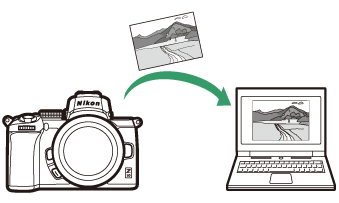
The Wireless Transmitter Utility
After configuring the camera for connection, you will need to pair it with the computer using the Wireless Transmitter Utility before you will be able to upload images via Wi-Fi. Once the devices are paired, you will be able to connect to the computer from the camera.
The Wireless Transmitter Utility is a computer application available for download from the Nikon Download Center:
https://downloadcenter.nikonimglib.com
Be sure to download the latest version after reading the release notes and system requirements.
Illustrations
The appearance and content of the software and operating system dialogs, messages, and displays shown in this guide may vary with the operating system used. For information on basic computer operations, see the documentation provided with the computer or operating system.
Infrastructure and Access-Point Modes
The camera can connect either via a wireless router on an existing network (infrastructure mode) or by direct wireless link (access-point mode).
Access-Point Mode
The camera and computer connect via direct wireless link, with the camera acting as a wireless LAN access point and without the need for complicated adjustments to settings. Choose this option when working outdoors or in other situations in which the computer is not already connected to a wireless network. The computer cannot access the Internet while connected to the camera.

Access-point mode
Infrastructure Mode
The camera connects to a computer on an existing network (including home networks) via a wireless router. The computer can still access the Internet while connected to the camera.

Infrastructure mode
Infrastructure Mode
This guide assumes you are connecting via an existing wireless network. Connection to computers beyond the local area network is not supported.
Connecting in Access-Point Mode
Follow the steps below to create a direct wireless link to a computer in access-point mode.
-
Display network settings.
Select Connect to PC in the camera setup menu, then highlight Network settings and press 2.
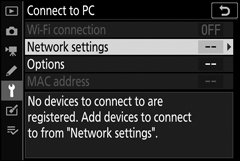
-
Select Create profile.
Highlight Create profile and press J.
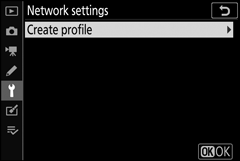
-
Select Direct connection to PC.
Highlight Direct connection to PC and press J.
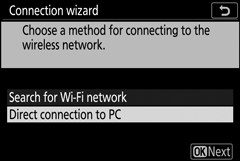
The camera SSID and encryption key will be displayed.
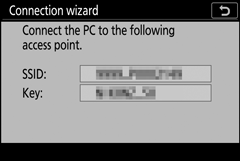
-
Connect from the computer.
Windows: Click the wireless LAN icon in the taskbar and select the SSID displayed by the camera in Step 3. When prompted to enter the network security key, enter the encryption key displayed by the camera in Step 3.
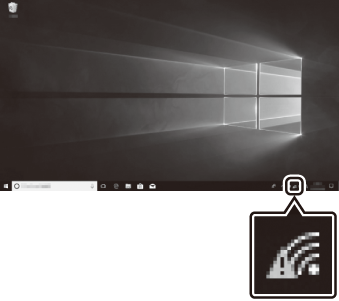
macOS/OS X: Click the wireless LAN icon in the menu bar and select the SSID displayed by the camera in Step 3. When prompted to supply a password, enter the encryption key displayed by the camera in Step 3.
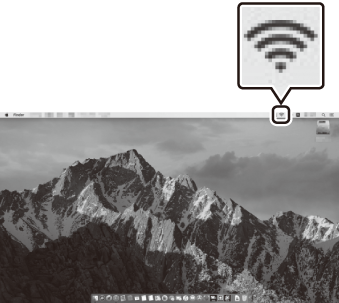
-
Launch the Wireless Transmitter Utility.
When prompted, launch the Wireless Transmitter Utility on the computer.
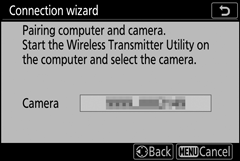
-
Select the camera.
In the Wireless Transmitter Utility, select the camera name displayed in Step 5 and click Next.
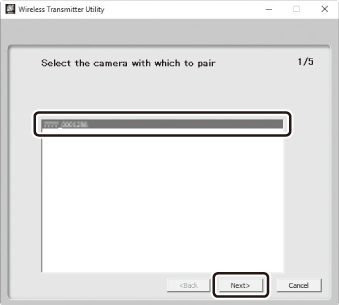
-
Enter the authentication code.
The camera will display an authentication code.
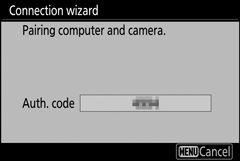
Enter the authentication code in the dialog displayed by the Wireless Transmitter Utility and click Next.
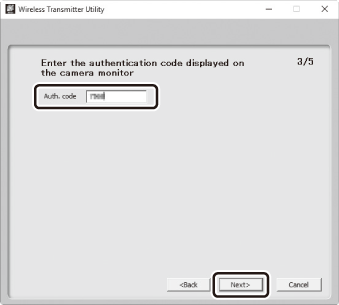
-
Complete the pairing process.
When the camera displays a message stating that pairing is complete, press J.

In the Wireless Transmitter Utility, click Next. You will be prompted to choose the destination folder; for more information, see online help for the Wireless Transmitter Utility.
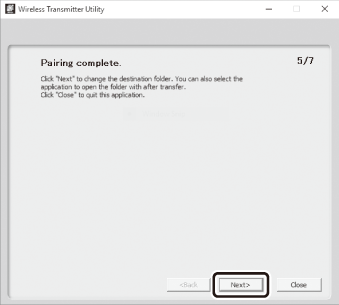
When you exit the Wireless Transmitter Utility after pairing is complete, a wireless connection will be established between the camera and computer.
-
Check the connection.
When a connection is established, the network SSID will be displayed in green in the camera Connect to PC menu.
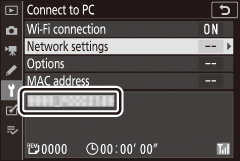
If the camera SSID is not displayed in green, connect to the camera via the wireless network list on your computer.
Now that a wireless connection has been established, you can upload images to the computer as described in“Uploading Pictures” (0 Uploading Pictures).
Connecting in Infrastructure Mode
Follow the steps below to connect to a computer on an existing network in infrastructure mode.
-
Display network settings.
Select Connect to PC in the camera setup menu, then highlight Network settings and press 2.

-
Select Create profile.
Highlight Create profile and press J.

-
Search for existing networks.
Highlight Search for Wi-Fi network and press J. The camera will search for networks currently active in the vicinity and list them by name (SSID).
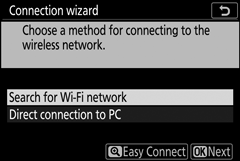
“Easy Connect”
To connect without entering an SSID or encryption key, tap X in Step 3, then press J and choose from the following options:
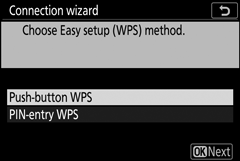
- Push-button WPS: For routers that support push-button WPS. Press the camera J button to connect.
- PIN-entry WPS: The camera will display a PIN; to connect, use a computer to enter the PIN into the router (for more information, see the documentation provided with the router).
After connecting, proceed to Step 6.
-
Choose a network.
Highlight a network SSID and press J (if the desired network is not displayed, tap X to search again). Encrypted networks are indicated by a h icon; if the selected network is encrypted, you will be prompted to enter the encryption key as described in Step 5. If the network is not encrypted, proceed to Step 6.
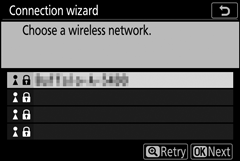
Networks with hidden SSIDs are indicated by blank entries in the network list. If you highlight a blank entry and press J, you will be prompted to provide the network name; press J, enter a name, and then tap X. Tap X again to proceed to Step 5.
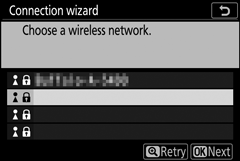
-
Enter the encryption key.
When prompted to enter the encryption key for the wireless router, press J…
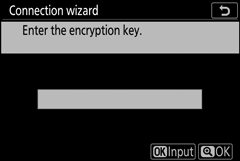
…and enter the key as described below. For information on the encryption key, see the documentation for the wireless router. Tap X when entry is complete.

Tap X again to initiate the connection. The message shown in the illustration will be displayed for a few seconds when the connection is established.
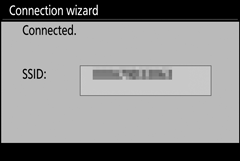
-
Obtain or select an IP address.
Highlight one of the following options and press J.
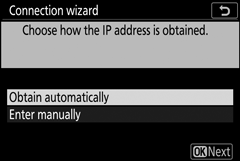
- Obtain automatically: Select this option if the network is configured to supply the IP address automatically.
- Enter manually: When prompted, enter an IP address by rotating the main command dial to highlight segments, pressing 4 and 2 to change and pressing J to accept. Tap X to exit to the “IP address configuration complete” dialog when entry is complete. Tapping X again displays the sub-net mask, which you can edit by pressing 1 and 3, pressing J to exit when entry is complete.
Confirm the IP address and press J to proceed.
-
Launch the Wireless Transmitter Utility.
When prompted, launch the Wireless Transmitter Utility on the computer.

-
Select the camera.
In the Wireless Transmitter Utility, select the camera name displayed in Step 7 and click Next.

-
Enter the authentication code.
The camera will display an authentication code.

Enter the authentication code in the dialog displayed by the Wireless Transmitter Utility and click Next.

-
Complete the pairing process.
Press J when the camera displays the message shown in the illustration.

In the Wireless Transmitter Utility, click Next. You will be prompted to choose the destination folder; for more information, see the Wireless Transmitter Utility online help.

When you exit the Wireless Transmitter Utility after pairing is complete, a wireless connection will be established between the camera and computer.
-
Check the connection.
When a connection is established, the network SSID will be displayed in green in the camera Connect to PC menu.

If the camera SSID is not displayed in green, connect to the camera via the wireless network list on your computer.
Now that a wireless connection has been established, you can upload images to the computer as described in “Uploading Pictures” (0 Uploading Pictures).
Uploading Pictures
You can select pictures for upload in the camera playback display or upload pictures as they are taken.
Destination Folders
By default, images are uploaded to the following folders:
- Windows: \Users\(user name)\Pictures\Wireless Transmitter Utility
- Mac: /Users/(user name)/Pictures/Wireless Transmitter Utility
The destination folder can be selected using the Wireless Transmitter Utility. For more information, see the utility’s online help.
Access Point Mode
Computers cannot access the Internet while connected to the camera in access point mode. To access the Internet, terminate the connection to the camera and then reconnect to a network with Internet access.
Selecting Pictures for Upload
Follow the steps below to select pictures for upload.
-
Start playback.
Press the K button on the camera and select full-frame or thumbnail playback.
-
Press the i button.
Select a picture and press the i button to display the playback i menu.
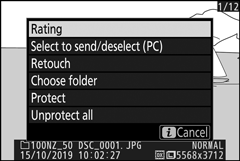
-
Choose Select to send/deselect (PC).
Highlight Select to send/deselect (PC) and press J. A white transfer icon will appear on the picture. If the camera is currently connected to a network, upload will begin immediately; otherwise, upload will begin when a connection is established. The transfer icon turns green during upload. Repeat Steps 2–3 to upload additional images.

Deselecting Pictures
To remove transfer marking from the current picture, highlight Select to send/deselect (PC) and press J. To remove transfer marking from all pictures, select Connect to PC > Options > Deselect all? in the setup menu.
Uploading Photos as They Are Taken
To upload new photos as they are taken, select On for Connect to PC > Options > Auto send. Upload begins only after the photo has been recorded to the memory card; be sure a memory card is inserted in the camera. Movies and photographs taken in movie mode are not uploaded automatically when recording is complete but must instead be uploaded from the playback display.
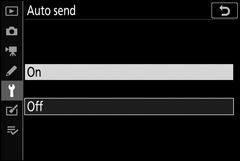
The Transfer Icon
Upload status is indicated by the transfer icon.

- Y (white): Send. The picture has been selected for upload but upload has not yet begun.
- X (green): Sending. Upload in progress.
- Y (blue): Sent. Upload complete.
The “Connect to PC” Status Display
The Connect to PC display shows the following information:
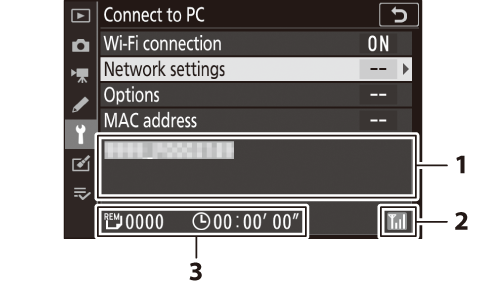
| 1 | Status |
The status of the connection to the host. The host name is displayed in green when a connection is established.
|
|---|---|---|
| 2 | Signal strength | Wireless signal strength. |
| 3 | Pictures/time remaining | The estimated time required to send the remaining pictures. |
Loss of Signal
Wireless transmission may be interrupted if the signal is lost, but can be resumed by turning the camera off and then on again.
Disconnecting and Reconnecting
The camera’s link to an existing network can be suspended or resumed as described below.
Disconnecting
You can disconnect by turning the camera off, selecting Disable for Connect to PC > Wi-Fi connection in the setup menu, or selecting Wi-Fi connection > Close Wi-Fi connection in the i menu for shooting mode. The connection to the computer will also end if you use Wi-Fi to connect to a smart device.
Access-Point Mode
A communication error will occur if the computer’s wireless connection is disabled before the camera’s. Disable camera Wi-Fi first.
Reconnecting
To reconnect to an existing network, either:
- select Enable for Connect to PC > Wi-Fi connection in the setup menu, or
- choose Wi-Fi connection > Establish Wi-Fi connection with PC in the i menu for shooting mode.
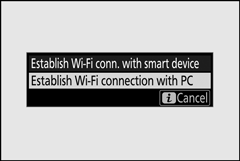
Access-Point Mode
Enable camera Wi-Fi before connecting.
Multiple Network Profiles
If the camera has profiles for more than one network, it will reconnect to the last network used. Other networks can be selected using the Connect to PC > Network settings option in the setup menu.
